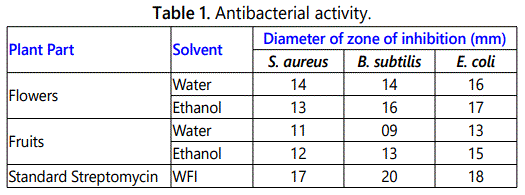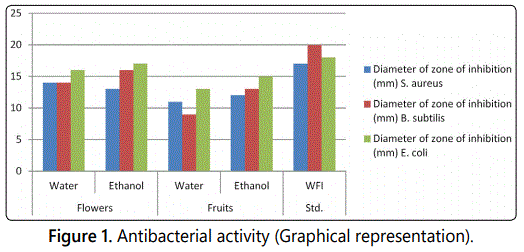Research Article
Estimation of Antibacterial activity of Crude Extracts of Thevetia Peruviana
Department of Pharmaceutics, S.M.B.T. College of Pharmacy, Nandi Hills, Dhamangaon, Nashik, India
*Corresponding author: Amol S Deshmukh, Assistant Professor Department of Pharmaceutics S.M.B.T. College of Pharmacy Nandi Hills, Dhamangaon, Nashik India Tel: +91 9371393020, E-mail: meamoldeshmukh@rediffmail.com
Received: March 11, 2019 Accepted: March 21, 2019 Published: March 28, 2019
Citation: Deshmukh AS, Dighe PR, Shelke SJ. Estimation of Antibacterial activity of Crude Extracts of Thevetia Peruviana. Int J Microbiol Curr Res. 2019; 1(1): 23-25. doi: 10.18689/ijmr-1000104
Copyright: © 2019 The Author(s). This work is licensed under a Creative Commons Attribution 4.0 International License, which permits unrestricted use, distribution, and reproduction in any medium, provided the original work is properly cited.
Abstract
Antimicrobial activity defined as the method of inhibiting or killing the microbes which causes disease. Various antimicrobial agents are used for this purpose. Antimicrobial may be antibacterial, anti-fungal or antiviral. Various medicinal plants shows vast majority of antimicrobial activity. Present work deals with the antibacterial activity of the crude extract of Thevetia peruviana. For this study flowers and fruits were extracted in water and methanol. Both extracts were treated for activity. Gram positive (Staphylococcus aureus, Bacillus subtilis) and gram negative (Escherichia coli) bacterial strains were used for activity. Marketed formulation of Streptomycin was used as a standard. Both extract shown significant antibacterial activity.
Keywords: Antibacterial activity; Thevetia peruviana.
Introduction
Plants have the capability to synthesize a wide variety of chemicals, some of which play an important role in primary metabolic activities while others are part of plantʼs secondary metabolism and can serve as a source of herbal drug development [1]. Medicinal plants represent a rich source of antimicrobial agents. In different countries various plants are used for medicinal purposes, and they acts as a source of many powerful and potent drugs. A wide range of medicinal plant parts is used for extract as raw drugs and they possess varied medicinal properties [2]. In the worldwide as well as in the developing countries, due to infectious bacterial diseases the most human beings get died. The various microorganisms including gram positive and gram negative bacteria like different species of Staphylococcus, Bacillus, Salmonella and Pseudomonas are the main source which causes severe infections in animals including humans. Because these organisms have the ability to survive in harsh condition due to their multiple environmental habitats [3]. Thevetia peruviana, belongs to the family Apocynaceae and commonly called as yellow oleander or Pila Kanher. Thevetia peruviana is generally grown as an ornamental plant and is planted as large flowering shrub or tree standards in parks, garden, road side and also used as road divider. It can grow in a broad range of polluted soil as well as dump site. It is also called phytoremediative plant. As this plant does not need much maintenance, it is also useful as a landscaping plant in warmer climates. Thevetia peruviana has valuable properties, one of them as seed oil was used in the preparation of bio pesticide. It contains a milky sap containing a compound-thevetin that is used as a heart stimulant but in its natural form, it is extremely poisonous, as all part of the plants, especially the seeds. It has immense medicinal properties. This plant is particularly known for its ability to produce cardiac glycosides; flavonol glycoside from leaves. Thevetia peruviana has inhibitory effect against HIV-1 reverse transcriptase and HIV-1 integrase. It has also been regarded as a potential source of biologically active compounds, namely insecticides, rodenticides, and bactericides. The plant parts used for the treatment of various disorders in human being such as liver toxicity fungal infection, microbial infection, inflammation, pyrexia and relive pain [4,5]. The problem of microbial resistance is growing day by day and the main point of view for the use of antimicrobial drugs in the future is still uncertain. Therefore, to decrease this problem of resistance the different actions must be taken for example, to control the use of antibiotic, develop a new research to better understand the mechanisms of antibiotic resistance and to continue with the studies to develop new drugs, which are either from synthetic or natural origin. The ultimate goal is to offer appropriate and efficient antimicrobial drugs to the patient [6]. The present study shows the antibacterial activity of crude extracts of Thevetia peruviana.
Materials and Methods
Materials
The plant leaves and flowers were collected from the region of highway Kolhar-Ghoti road, Rajur, from taluka Akole, of Ahmednagar district. All plant parts were washed with running tap water and shade dried. Then dried plant material powdered using an electric blender. The chemicals and microorganism cultures used for the study were provided by the SMBT College of pharmacy, Dhamangaon, Nashik under Pune University. All the experimental work was carried out in microbiology laboratory of the college in year 2018.
Method
Antibacterial assay of Thevetia peruviana extracts.
Extraction of plant material
50 grams of shade dried and powdered material of flowers and fruits of Thevetia peruviana were taken and extracted with ethanol and distilled water at 60°-80°C. The extracts were filtered with whatman filter paper no 1. Each of the extracts dried in vacuum and stored at 4°C for further experiments [1,7].
Test microorganism
Three bacterial strains Staphylococcus aureus, Bacillus subtilis (Gram-positive) and Escherichia coli (Gram-negative) were used in this study. The pure bacterial cultures were maintained on nutrient agar medium. Each bacterial culture was further maintained by sub-culturing regularly on the slants of the same medium [7,8].
Preparation of bacterial suspension
Test bacterial strain was grown in nutrient broth for 18-24 hours at 37°C. The bacterial suspension was prepared by transferring a loopful of inoculum into normal saline (0.9%) under aseptic conditions from the stock culture maintained at 4°C and used as the inoculums for performing agar well diffusion assay [9,10].
Screening for antimicrobial activity
The aqueous and ethanol extracts of yellow oleander fruits and flowers were used for evaluation of antimicrobial activity by the agar well diffusion method. Nutrient agar plates were prepared for the growth of bacterial cultures. By spread plate method test cultures were spread on the agar plates. Test cultures were used such as Staphylococcus aureus, Bacillus subtilis (Gram-positive) and Escherichia coli (Gram-negative). By using sterilized cork borer well were prepared in seeded plates. Plant extracts 0.1 ml was added in the labelled wells. Plates were incubated at 37°C for 48 hrs. One well was prepared as control having 0.1 ml of pure solvent. The sensitivity of test organism to each of extracts was indicated by clear zones of inhibition around the well and measured the diameter of the clear zone of inhibition [11-13].


The antibacterial activity of aqueous and ethanol extracts of flowers and fruits of Thevetia peruviana was assayed in-vitro by an agar well diffusion method against three different bacterial strains namely Staphylococcus aureus, Bacillus subtilis (Gram-positive) and Escherichia coli (Gram-negative). As per the observations shown in table 1 and figure 1 for the flowers, aqueous and ethanolic extract shown maximum antibacterial activity against E.coli with zone of inhibition 16 mm and 17 mm respectively. For the fruits, aqueous and ethanolic extract shown maximum antibacterial activity against E.coli with zone of inhibition 13 mm and 15 mm respectively.
Discussion
This study can be concluded that plants are the important source of different active agent which has various properties. Many reports are available that gives the work of different researchers showing the important properties and uses of such active agents obtained from the plant extracts. Among them antibacterial activity is one of the important property of active constituents of some plants. Present study shows the antibacterial activity of aqueous and ethanolic extract of plant Thevetia peruviana. This will be beneficial to use such active constituents as antibacterial agents obtained from the natural sources. There is a better scope to develop drugs from natural sources to diminish antibiotic resistance and to fight against bacterial pathogens.
References
- Dixit A, Singh H, Sharma R, Sharma A. Estimation of Antioxidant and Antibacterial Activity of Crude Extracts of Thevetia Peruviana (Pers.) K. Schum. Int J Pharm Pharm Sci. 2015; 7(2): 55-59.
- Mahesh B, Satish S. Antimicrobial Activity of Some Important Medicinal Plant against Plant and Human Pathogens. World Journal of Agricultural Sciences. 2008; 4(5): 839-843.
- Yamin B, Sobia N, Chaudhary FM, Muhammad Z. Antibacterial Activity of Some Selected Medicinal Plants of Pakistan. BMC Complement Altern Med. 2011; 11: 52. doi: 10.1186/1472-6882-11-52
- Deshmukh AS. Pharmacognostic and Preliminary Physiochemical Investigations of Plant Thevetia Peruviana Leaves and Flowers. International Journal of Pharmacognosy. 2014; 1(10): 650-653. doi: 10.13040/IJPSR.0975-8232.IJP
- Alhashimi SKM, Khaleel IR, Saleh GS, Abdulhadi AM, Taher TA. The Antimicrobial Activity of Leaves and Callus Extracts of Thevetia Peruviana in-vitro. Journal of Biotech Research Center. 2013; 7(3): 74-80.
- Nascimento GGF, Locatelli J, Freitas PC, Silva GL. Antibacterial Activity of Plant Extracts and Phytochemicals on Antibiotic Resistant Bacteria. Braz J Microbiol. 2000; 31(4): 247-256. doi: 10.1590/S1517-83822000000400003
- Farjana A, Zerin N, Kabir S. Antimicrobial Activity of Medicinal Plant Leaf Extracts against Pathogenic Bacteria. Asian Pac J Trop Dis. 2014; 4(2): 920-923. doi: 10.1016/S2222-1808(14)60758-1
- Mikayel G, Margarit P, Armen T. Antimicrobial Activity of Some Plant Materials used in Armenian Traditional Medicine. BMC Complement Altern Med. 2017; 17(50): 1-9. doi: 10.1186/s12906-017-1573-y
- Akila P, Prince L, Bharathidasan R, Krishnapriya K. Antibacterial Activity of Herbal Plants. Int J Curr Microbiol App Sci. 2016; 5(4): 681-688. doi: 10.20546/ijcmas.2016.504.078
- Sen A, Batra A. Evaluation of Antimicrobial Activity of different solvent extracts of Medicinal Plant: Melia Azedarach L. Int J Curr Pharma Res. 2012; 4(2): 67-73.
- Jahangirian H, Jelas Haron MD, Halim Shah Ismail Md, et al. Well Diffusion Method for Evaluation of Antibacterial Activity of Copper Phenyl Fatty Hydroxamate Synthesized from Canola and Palm Kernel Oils. Digest Journal of Nanomaterials & Biostructures. 2013; 8(3): 1263-1270.
- Balouiri M, Sadiki M, Saad KI. Methods for in vitro Evaluating Antimicrobial Activity: A Review. J Pharm Anal. 2016; 6(2): 71-79. doi: 10.1016/j.jpha.2015.11.005.


